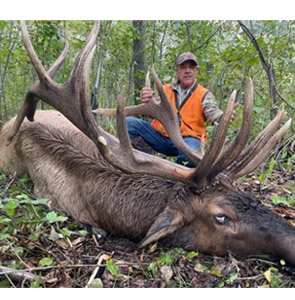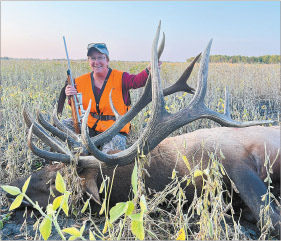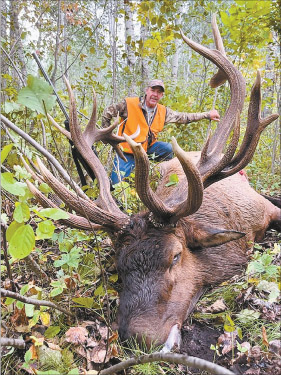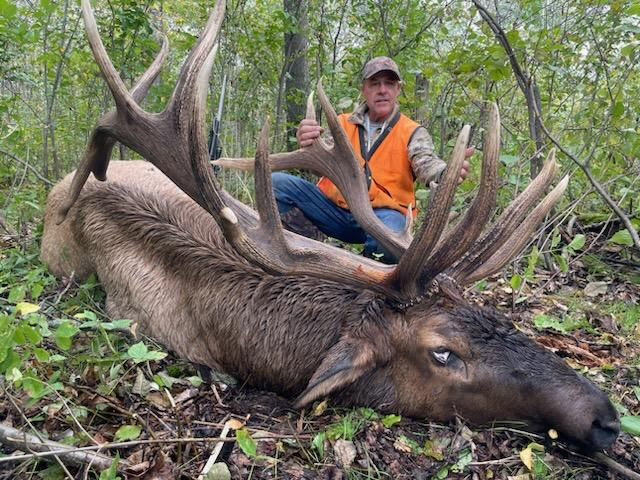
POTENTIAL NEW #2 NONTYPICAL BULL ELK
Gary Przekwas shot this 10 x 11 bull elk on Sept 11 in Kittson County. The antlers scored 413 7/8 net nontypical.
Roseau siblings kill two massive bull elk

By Brian Mozey
Staff Writer
Roseau, Minn.
Gary Przekwas, 58, and Sharlene Peterson, 63, have applied for Minnesota’s elk-hunting license lottery since the hunt began in 2008, for zones 20 and 30 in the Kittson Central hunting area. The brother and sister have dreamed about hunting elk in Minnesota for years.
In 2023, they drew once-in-a-lifetime licenses and recently, both shot bulls. Przekwas’ elk sported 10-by-11 nontypical antlers, and Peterson’s elk had a 7‑by‑7 rack. Both created memories that’ll last a lifetime.
“I was in disbelief the whole time,” Przekwas said. “I don’t know how many prayers I’ve said, but I’m so grateful for (the opportunity).”
Przekwas and Peterson both live in Roseau and have coffee together each morning. Peterson retired in 2022 from working at a hospital, and Przekwas is a water operator and assistant superintendent for the city of Roseau.
A Minnesota elk license is tough to draw; only 17 state licenses were available for the 2023 season.
Peterson recalls the recent mid-July morning she walked to her mailbox, and as she flipped through bills and junk mail, she noticed a Minnesota DNR postcard. It said she’d been selected for a 2023 elk license.
“I couldn’t even compose myself,” Peterson said.

She immediately called Przekwas to tell him the good news, then the next morning, around 7 a.m., Przekwas found a postcard saying he, too, had received an elk license. Morning coffee sessions after that focused on planning their elk hunts.
“I had said if we get one tag in our family in our lifetime, that’ll be great,” Przekwas said. “Then, we got two.”
Peterson received a land owner’s license and Przekwas received a 10-year license, which is a special drawing for applicants who have applied for more than a decade. They each earned a license for either sex in Zone 30. Peterson and Przekwas have land in the Zone 30 area that’s been in the family since 1920.
After getting the postcards, the siblings started scouting. They’ve succeeded with elk hunting during past trips to Colorado. As the season approached, they would head out at 5 a.m. and listen for bull elk bugling. It helped with their scouting, especially as hunt week got closer.
Peterson’s elk hunt started and ended on Saturday, Sept. 9. She drove to her hunting site around 4 a.m. and checked the wind, which was blowing the wrong way for her stand at first.
An hour after reaching her stand, a big bull came from 225 yards away. She couldn’t get a shot, but she stayed in the stand for a few hours then switched stands to play the wind.
In the evening, the bull eventually exited brush walking hard and fast. Peterson made a small noise to stop him for a moment, and she shot. At about 250 yards away, the elk was hit and 30 seconds later, it dropped to the ground. Peterson shot around 7 p.m. with a 7mm-08 Remington.
“You get speechless,” Peterson said. “I just said, ‘what a magnificent experience to have.’ I wish more people could experience this.”
Przekwas had a similar result, but a different story. He hunted all weekend but didn’t shoot his elk until Monday morning, Sept. 11. He walked out at 5 a.m. to the side woods of their property and started bulging. He heard some elk, but suspected they were smaller.
Initially, Przekwas had his sights on an 8‑by‑8 bull until his neighbor showed him images of a 10-by-11 elk he’d seen near his property. After seeing the photos, he changed his plan.
After bulging for a bit, he tried a cow elk call, and his targeted bull came through the woods “like a freight train.” The elk, which appeared to have branches in its antlers, slowed broadside for a moment and Przekwas took a shot, but it wasn’t a great shot.
He shot again with his .300 Remington Ultra Mag, then waited nervously. Przekwas waited until about 10:30 a.m. to walk into the woods and they found blood. Eventually, the blood trail went cold but after 90 minutes of searching, they found the elk.
Przekwas has been to Colorado for 10 seasons, so he’s now shot 11 bulls in 11 seasons. Even so, he admitted getting emotional about this animal.
“I’ve been hunting for so long, and I know the value of something like that. I’ve hunted in the mountains, and I’ve never seen something like that. I’ve seen big elk out (in Colorado), but nothing like this,” Przekwas said.
By Monday night, Przekwas said there more than 80 people at their property celebrating their fine weekend. The best part for the two hunters is sharing this moment with grandchildren, children, and other family members and friends.
Przekwas and Peterson doubted whether they’d ever get an elk license, but they stayed positive and it paid off.

Peterson has heard people say that they’d choose a Minnesota elk license over the Minnesota lottery.
The two elk cannot be officially scored until after a 60-day dry-down period, but Randy Dufault, a certified measurer for the Boone and Crockett Club in East Grand Forks, said Ryan Spindler unofficially green-scored the bull elk on Monday, Sept. 11. Dufault said Spindler is a bear guide and has experience scoring trophy animals. He’s also neighbors to Przekwas and Peterson.
Dufault said Przekwas’ elk was green-scored at 413 7⁄8, which would place the rack third among the Minnesota state records in the nontypical elk category. A bull taken by Bradley Penas currently is second at 419, and the largest was found dead at 462 2⁄8, according to Boone and Crockett Club website.
Peterson’s elk green-scored 368, which puts her at second for the Minnesota state record in the typical elk category. She’s behind G.R. Rode and J.L. Dale, who hold the top spot at 371 6⁄8, according to Boone and Crockett Club website.
Dufault said he’ll travel to Roseau to score both elk after the 60-day dry-down period.
Early success for elk hunters
Jason Wollin, the Minnesota DNR’s Karlstad-area wildlife supervisor, provided an elk season update on Tuesday, Sept. 19, after the first season ended.
Hunters were three-for-three for harvested bulls in Zone 30, two-for-two for harvested bulls in Zone 20, and one of two hunters filled their antlerless-only tags in Zone 20. The first season concluded Sept. 17, and the second season begins Sept. 23.
